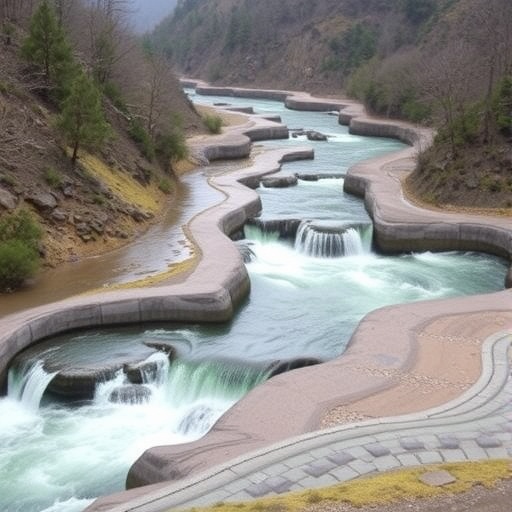In a groundbreaking study published in Commun Earth Environ, researchers Zhang, Fan, and Tjiputra et al. explore the complex dynamics of climate interventions and their divergent impacts on China’s north-south water divide. The study sheds light on the pressing issue of water resource management in a country characterized by stark geographical and climatic disparities, which ultimately affect agricultural productivity, economic stability, and societal well-being. With countries around the globe grappling with the consequences of climate change, this research contributes significantly to the understanding of localized climate strategies and their effectiveness in mitigating environmental challenges.
The fundamental premise of the study revolves around the differing climatic conditions experienced in China’s northern and southern regions. The north, generally characterized by aridity and limited water resources, faces significant risks concerning agricultural sustainability and food security. Conversely, the south is endowed with more abundant water resources, which could be utilized more effectively with the right climate interventions. The study highlights that achieving a balance in water distribution and management between these two regions is not only necessary but also critical for long-term sustainability.
One of the core findings of the research emphasizes that climate interventions, including technological advancements in water management and policy reforms, can yield vastly different results depending on regional variables. For instance, the implementation of precipitation modification techniques, such as cloud seeding, may offer much-needed relief to parched areas in northern China by enhancing rainfall. However, the same interventions can lead to unintended consequences in the south, where excessive precipitation can create flooding risks or exacerbate soil erosion, highlighting the necessity for region-specific approaches to climate intervention.
Furthermore, the study employs quantitative modeling to simulate the outcomes of various climate intervention strategies, enabling the researchers to assess potential impacts on water distribution. By integrating climate projections with socioeconomic data, the authors were able to create comprehensive scenarios that elucidate how different strategies might unfold across different geographies and climates. This approach allows for a more nuanced understanding of the impacts of climate change on water resources, thereby facilitating better-informed decision-making for policymakers.
Engaging with the social dimensions of climate interventions, the research also addresses the disparities in economic power and technological access between the north and south. Regions with greater financial and infrastructural resources are better positioned to implement effective climate strategies, while those lacking in these areas may struggle to adapt. These inequities exacerbate the existing north-south divide and pose challenges not only to water resource management but to broader societal equity as well. The researchers argue that any successful intervention must authentically engage with these disparities and prioritize inclusive approaches that ensure equitable access to water resources.
The study further stresses the importance of public awareness and community involvement in the planning and execution of climate interventions. When local communities are actively engaged in the decision-making processes regarding water management, interventions tend to be more successful. The researchers note that empowering local populations to address their water-related challenges leads to more sustainable outcomes and fosters community resilience amidst ongoing climate variability.
As the authors discuss the implications of their findings, they call for a cross-regional collaborative approach to water resource management. Such collaboration could enhance resource sharing between the north and south, allowing for innovative strategies that align with local capacities and needs. By creating a framework for cooperative governance, stakeholders can pool their resources and knowledge to devise comprehensive solutions that address the multifaceted challenges posed by climate change on water resources.
Moreover, the researchers advocate for a shift in focus from mere technological solutions to more holistic approaches embracing traditional water conservation methods. By integrating indigenous knowledge systems and historical practices with modern science, communities can develop sustainable strategies that honor their unique cultural contexts while providing tangible benefits. The fusion of old and new methods may hold the key to navigating the challenges of climate variability while fostering a sustainable future.
In contemplating the trajectory of climate interventions, the study emphasizes the need for continued research and adaptive management. As climate conditions evolve, so too must the strategies employed to manage water resources. The authors propose the establishment of an adaptive framework to assess the efficacy of interventions regularly. This would allow for the iterative modification of strategies and ensure that they remain relevant to changing climatic conditions and population needs.
In conclusion, Zhang, Fan, Tjiputra, and their colleagues present a compelling argument for the need to tailor climate interventions to address the unique challenges presented by China’s north-south water divide. By recognizing the differential impacts of such strategies, the research not only enriches the discourse surrounding climate interventions but also provides a roadmap for future exploration. The necessity of integrated approaches that embrace both technological innovation and local engagement emerges as a central theme, signaling a promising path forward in the realm of climate change mitigation and water resource sustainability.
Ultimately, this study serves as a call to action for researchers, policymakers, and communities alike to engage collaboratively in rethinking approaches to climate interventions that address regional disparities. Only through such collective efforts can we hope to confront the looming challenges posed by climate change and ensure the equitable distribution of vital resources for generations to come.
Subject of Research: Divergent impacts of climate interventions on water resource management in China.
Article Title: Divergent impacts of climate interventions on China’s north-south water divide.
Article References:
Zhang, X., Fan, Y., Tjiputra, J. et al. Divergent impacts of climate interventions on China’s north-south water divide.
Commun Earth Environ 6, 736 (2025). https://doi.org/10.1038/s43247-025-02708-0
Image Credits: AI Generated
DOI:
Keywords: Climate interventions, water resources, north-south water divide, China, sustainability, socioeconomic disparities, public awareness, adaptive management, regional collaboration.




